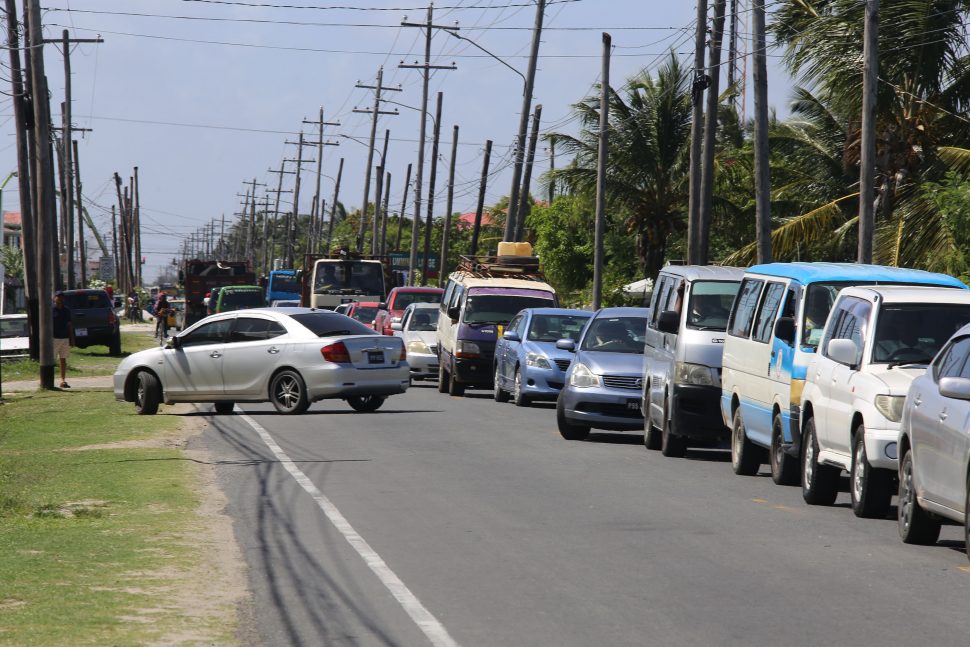It took three hours for some commuters to travel from La Bonne Intention (LBI) to Plaisance yesterday afternoon following the closure of the East Coast Highway to facilitate the construction of culverts and bridges as part of the road widening and upgrade project.
The Ministry of Public Infrastructure has said the road, which was closed at 8 am yesterday, will not reopen until 11 pm today.
In light of the resulting congestion caused by the diversion of traffic along the railway embankment, minibus operators either stopped travelling to the city or made the trip at the inflated price of $500. In some cases, taxi drivers moved their fare from $2,000 to $4,000, citing the impact on their gas consumption due to the long wait.
Despite the fact that the China Railway Group Company has been contracted to improve the traffic management along the East Coast road through a series of upgrades, even before yesterday’s debacle, drivers and residents that frequently use the road have had cause to call for better management practices from the project managers to ease the congestion experienced during the peak hours.
Residents and drivers have created a furore on Facebook, expressing their concerns about the way traffic is being managed along the highway.
According to one driver, Amanda Tiwari, the management of the project has many issues which make it difficult for traffic to flow properly.
“The current state of the East Coast road is an indictment to road users and clearly illustrates that no consideration is given to the lengthy delays experienced by road users daily. More importantly, this project is a major safety risk and will sooner or later result in fatalities,” she said.
Tiwari explained that in some sections, during the nights, visibility is extremely poor and drivers can hardly identify the signs to show where the diversions start and end. She also pointed out that the signs that are placed are not reflective and that gaining access to premises for some is difficult as “an entire community (Annandale) was cut off because of poorly planned construction and total disregard for emergencies”.
She pointed out that even though the railway embankment is left open to facilitate the brunt of the traffic, she noted that during peak time, the traffic is “bumper to bumper” and moves at a snail’s pace.
“I will say this, as a professional in the technical field, the way this project is unfolding is a national disgrace and only highlights our inability to resolve simple issues by not demanding better from contractors… The functionality of the road is important to ensure that people get to school and work,” she said, while adding that she wishes that persons would come out and protest against the way the work is progressing and the inconveniences that are being caused.
Drivers told this newspaper on Friday that during the evenings, the line of traffic usually extends to Sherriff Street and sometimes beyond.
“In the nights you spend at least an hour in the traffic and especially with the rain falling almost every day, pot holes are created on the crusher run, that just slows the whole traffic down because people now have to drive extra slowly. Sometimes you can’t even see the diversion signs and is not like you can remember them because they are always changing,” one driver said.
Since the start of the project, drivers and residents have complained about the congestion. Nigel Erskine, Technical Services Manager for roads, attached to the Ministry of Public Infrastructure, had previously said that changes were made to better manage the traffic, including the placement of more traffic signs.
Erskine also said that errant road users who refuse to wait in the traffic line are also a major contributing factor to the congestion.
“What is happening is that the congestion is happening during the peak period [and] in a lot of the cases what is contributing to the congestion is indiscipline. You would have only one lane to go through the intersection at the bridges but what you would have is that like three lanes of traffic are converging at that point and only one can go through so that results in everyone being at a standstill,” he explained.
He also noted that the audit would’ve found that the offloading of materials during peak time would have also been a contributing factor to the slow traffic. To remedy this, they instructed the contractor to stop offloading material during the peak period.
The contractor also reportedly increased the capacity of their flagmen and the amount that were placed on the road way.
Erskine had also explained that paving of the road had commenced from Better Hope to Montrose and once completed, will greatly ease the congestion along that section.
“I feel once the paving works start you will see a lot of ease in the terms of the build-up of traffic because you can go at higher speeds. Currently, overall, it’s at 40% [completed] but works are only going on the four-lane section which is about 70% completed. We’re working towards substantial completion by the end of the year and I mean that most of the paving works for the four-lane section should be at 90% and just minor works will be left,” he added.
Work on the project began last year August and is expected to be completed by August 2019. The project will see the widening of the carriageway from a two-lane road into four lanes between Better Hope and Annandale. After Annandale, there will be an asphaltic concrete surface upgrade up to Belfield.
The US$46,995,941.34 contract for the works is being funded by the Government of Guyana and the Export-Import Bank of China.






